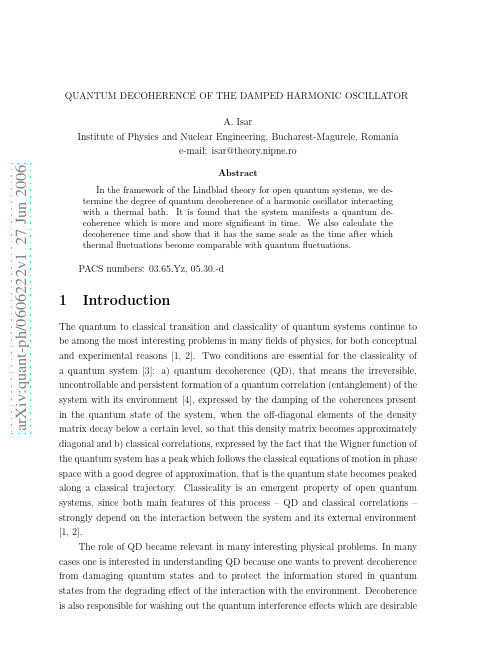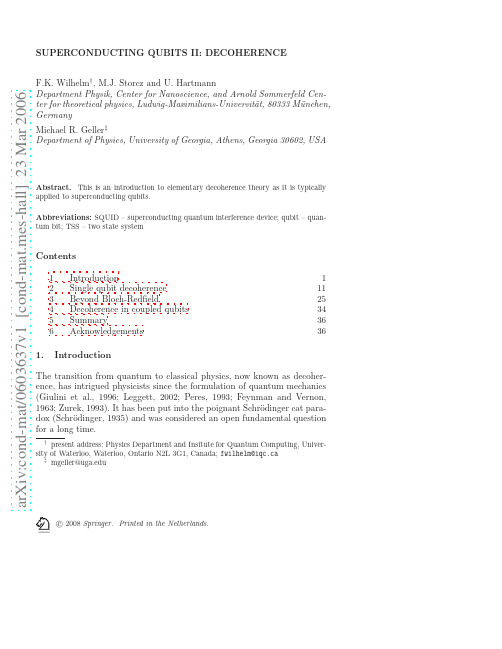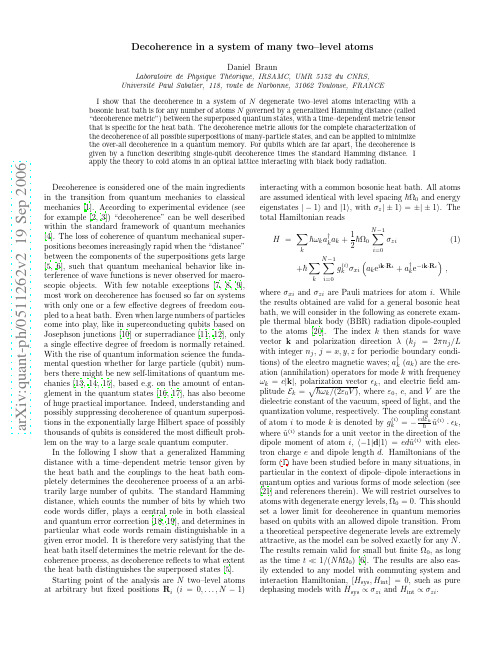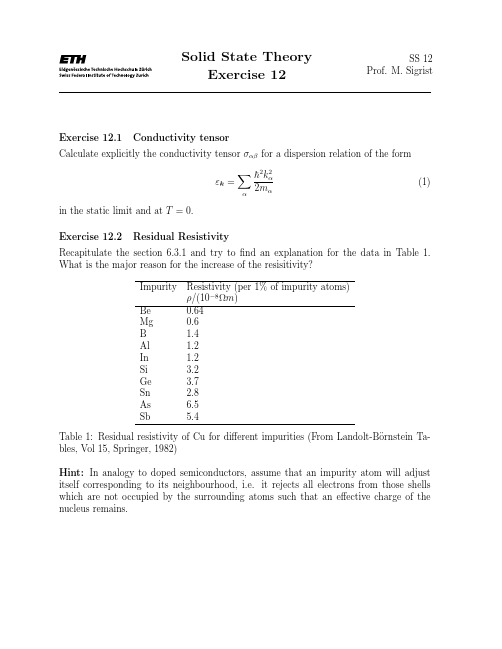Decoherence of Schrodinger cat states in a Luttinger liquid
- 格式:pdf
- 大小:421.06 KB
- 文档页数:28

a r X i v :q u a n t -p h /0606222v 1 27 J u n 2006QUANTUM DECOHERENCE OF THE DAMPED HARMONIC OSCILLATORA.IsarInstitute of Physics and Nuclear Engineering,Bucharest-Magurele,Romaniae-mail:isar@theory.nipne.roAbstract In the framework of the Lindblad theory for open quantum systems,we de-termine the degree of quantum decoherence of a harmonic oscillator interacting with a thermal bath.It is found that the system manifests a quantum de-coherence which is more and more significant in time.We also calculate the decoherence time and show that it has the same scale as the time after which thermal fluctuations become comparable with quantum fluctuations.PACS numbers:03.65.Yz,05.30.-d 1Introduction The quantum to classical transition and classicality of quantum systems continue to be among the most interesting problems in many fields of physics,for both conceptual and experimental reasons [1,2].Two conditions are essential for the classicality of a quantum system [3]:a)quantum decoherence (QD),that means the irreversible,uncontrollable and persistent formation of a quantum correlation (entanglement)of the system with its environment [4],expressed by the damping of the coherences present in the quantum state of the system,when the off-diagonal elements of the density matrix decay below a certain level,so that this density matrix becomes approximatelydiagonal and b)classical correlations,expressed by the fact that the Wigner function of the quantum system has a peak which follows the classical equations of motion in phase space with a good degree of approximation,that is the quantum state becomes peaked along a classical trajectory.Classicality is an emergent property of open quantum systems,since both main features of this process –QD and classical correlations –strongly depend on the interaction between the system and its external environment[1,2].The role of QD became relevant in many interesting physical problems.In manycases one is interested in understanding QD because one wants to prevent decoherence from damaging quantum states and to protect the information stored in quantum states from the degrading effect of the interaction with the environment.Decoherence is also responsible for washing out the quantum interference effects which are desirableto be seen as signals in experiments.QD has a negative influence on many areas relying upon quantum coherence effects,in particular it is a major problem in quantum optics and physics of quantum information and computation[5].In this work we study QD of a harmonic oscillator interacting with an environ-ment,in particular with a thermal bath,in the framework of the Lindblad theory for open quantum systems.We determine the degree of QD and then we apply the criterion of QD.We consider different regimes of the temperature of environment and it is found that the system manifests a QD which in general increases with time and temperature.The organizing of the paper is as follows.In Sec.2we review the Lindblad master equation for the damped harmonic oscillator and solve the master equation in coordinate representation.Then in Sec.3we investigate QD and in Sec.4we calculate the decoherence time of the system.We show that this time has the same scale as the time after which thermalfluctuations become comparable with quantum fluctuations.A summary and concluding remarks are given in Sec.5.2Master equation and density matrixIn the Lindblad axiomatic formalism based on quantum dynamical semigroups,the irreversible time evolution of an open system is described by the following general quantum Markovian master equation for the density operatorρ(t)[6]:dρ(t)¯h [H,ρ(t)]+12(qp+pq),H0=12q2(2)and the operators V j,V†j,which model the environment,are taken as linear polynomials in coordinate q and momentum p.Then the master equation(1)takes the following form[7]:dρ¯h [H0,ρ]−i2¯h(λ−µ)[p,ρq+qρ]−D pp¯h2[p,[p,ρ]]+D pqcase when the asymptotic state is a Gibbs stateρG(∞)=e−H0kT,these coeffi-cients becomeD pp=λ+µ2kT,D qq=λ−µmωcoth¯hω2kT≥λ2(5)and the asymptotic valuesσqq(∞),σpp(∞),σpq(∞)of the dispersion(variance),re-spectively correlation(covariance),of the coordinate and momentum,reduce to[7]σqq(∞)=¯h2kT,σpp(∞)=¯h mω2kT,σpq(∞)=0.(6)We consider a harmonic oscillator with an initial Gaussian wave function(σq(0) andσp(0)are the initial averaged position and momentum of the wave packet)Ψ(q)=(14exp[−1¯hσpq(0))(q−σq(0))2+i 2mω,σpp(0)=¯h mω2√∂t=i¯h∂q2−∂22¯h(q2−q′2)ρ−1∂q−∂2(λ−µ)[(q+q′)(∂∂q′)+2]ρ−D pp∂q+∂∂q+∂a damping effect(exchange of energy with environment).The last three are noise (diffusive)terms and producefluctuation effects in the evolution of the system.D pp promotes diffusion in momentum and generates decoherence in coordinate q–it re-duces the off-diagonal terms,responsible for correlations between spatially separated pieces of the wave packet.Similarly D qq promotes diffusion in coordinate and gener-ates decoherence in momentum p.The D pq term is the so-called”anomalous diffusion”term and it does not generate decoherence.The density matrix solution of Eq.(9)has the general Gaussian form<q|ρ(t)|q′>=(12exp[−12−σq(t))2−σ(t)¯hσqq (t)(q+q′¯hσp(t)(q−q′)],(10)whereσ(t)≡σqq(t)σpp(t)−σ2pq(t)is the Schr¨o dinger generalized uncertainty function. In the case of a thermal bath we obtain the following steady state solution for t→∞(ǫ≡¯hω/2kT):<q|ρ(∞)|q′>=(mω2exp{−mωcothǫ+(q−q′)2cothǫ]}.(11)3Quantum decoherenceAn isolated system has an unitary evolution and the coherence of the state is not lost–pure states evolve in time only to pure states.The QD phenomenon,that is the loss of coherence or the destruction of off-diagonal elements representing coherences between quantum states in the density matrix,can be achieved by introducing an interaction between the system and environment:an initial pure state with a density matrix which contains nonzero off-diagonal terms can non-unitarily evolve into afinal mixed state with a diagonal density matrix.Using new variablesΣ=(q+q′)/2and∆=q−q′,the density matrix(10) becomesρ(Σ,∆,t)= πexp[−αΣ2−γ∆2+iβΣ∆+2ασq(t)Σ+i(σp(t)2σqq(t),γ=σ(t)¯hσqq(t).(13)The representation-independent measure of the degree of QD[3]is given by the ratio of the dispersion1/√2/αof the diagonal elementρ(Σ,0,t):δQD(t)=1α24{e−4λt[1−(δ+1δ(1−r2)−2cothǫ)ω2−µ2cos(2Ωt)δ(1−r2))µsin(2Ωt)Ω2√2kT,(16)which for high T becomesδQD(∞)=¯hω/2kT.We see thatδQD decreases,and therefore QD increases,with time and temperature,i.e.the density matrix becomes more and more diagonal at higher T and the contributions of the off-diagonal elements get smaller and smaller.At the same time the degree of purity decreases and the degree of mixedness increases with T.For T=0the asymptotic(final)state is pure andδQD reaches its initial maximum value1.δQD=0when the quantum coherence is completely lost,and ifδQD=1there is no QD.Only ifδQD<1we can say that the considered system interacting with the thermal bath manifests QD,when the magnitude of the elements of the density matrix in the position basis are peaked preferentially along the diagonal q=q′.Dissipation promotes quantum coherences, whereasfluctuation(diffusion)reduces coherences and promotes QD.The balance of dissipation andfluctuation determines thefinal equilibrium value ofδQD.The initial pure state evolves approximately following the classical trajectory in phase space and becomes a quantum mixed state during the irreversible process of QD.4Decoherence timeIn order to obtain the expression of the decoherence time,we consider the coefficientγ(13),which measures the contribution of non-diagonal elements in the density matrix(12).For short times(λt≪1,Ωt≪1),we have:γ(t)=−mωδ(1−r2))cothǫ+µ(δ−r2δ√2[λ(δ+r2δ(1−r2))cothǫ−λ−µ−ωr1−r2].(18)The decoherence time depends on the temperature T and the couplingλ(dissipation coefficient)between the system and environment,the squeezing parameterδand the initial correlation coefficient r.We notice that the decoherence time is decreasing with increasing dissipation,temperature and squeezing.For r=0we obtain:t deco=12λ(δ−1).(20) We see that when the initial state is the usual coherent state(δ=1),then the deco-herence time tends to infinity.This corresponds to the fact that for T=0andδ=1 the coefficientγis constant in time,so that the decoherence process does not occur in this case.At high temperature,expression(18)becomes(τ≡2kT/¯hω)t deco=1δ(1−r2))+µ(δ−r24(λ+µ)δkT.(22) The generalized uncertainty functionσ(t)(15)has the following behaviour for short times:σ(t)=¯h2δ(1−r2))cothǫ+µ(δ−1This expression shows explicitly the contribution for small time of uncertainty that is intrinsic to quantum mechanics,expressed through the Heisenberg uncertainty prin-ciple and uncertainty due to the coupling to the thermal environment.From Eq.(23)we can determine the time t d when thermalfluctuations become comparable with quantumfluctuations.At high temperature we obtain1t d=)+µ(δ−1δ(1−r2)squeezing and correlation,it depends on temperature only.QD is expressed by theloss of quantum coherences in the case of a thermal bath atfinite temperature.(2)We determined the general expression of the decoherence time,which showsthat it is decreasing with increasing dissipation,temperature and squeezing.We havealso shown that the decoherence time has the same scale as the time after which thermalfluctuations become comparable with quantumfluctuations and the valuesof these scales become closer with increasing temperature and squeezing.After the decoherence time,the decohered system is not necessarily in a classical regime.There exists a quantum statistical regime in between.Only at a sufficiently high temperaturethe system can be considered in a classical regime.The Lindblad theory provides a self-consistent treatment of damping as a general extension of quantum mechanics to open systems and gives the possibility to extendthe model of quantum Brownian motion.The results obtained in the framework ofthis theory are a useful basis for the description of the connection between uncertainty, decoherence and correlations(entanglement)of open quantum systems with their en-vironment,in particular in the study of Gaussian states of continuous variable systemsused in quantum information processing to quantify the similarity or distinguishabilityof quantum states using distance measures,like trace distance and quantumfidelity. AcknowledgmentsThe author acknowledges thefinancial support received within the Project PN06350101/2006. References[1]E.Joos,H.D.Zeh,C.Kiefer,D.Giulini,J.Kupsch,I.O.Stamatescu,Decoherenceand the Appearance of a Classical World in Quantum Theory(Springer,Berlin,2003).[2]W.H.Zurek,Rev.Mod.Phys.75,715,2003.[3]M.Morikawa,Phys.Rev.D42,2929(1990).[4]R.Alicki,Open Sys.and Information Dyn.11,53(2004).[5]M.A.Nielsen and I.L.Chuang,Quantum Computation and Quantum Information(Cambridge Univ.Press,Cambridge,2000).[6]G.Lindblad,Commun.Math.Phys.48,119(1976).[7]A.Isar,A.Sandulescu,H.Scutaru,E.Stefanescu,W.Scheid,Int.J.Mod.Phys.E3,635(1994).[8]A.Isar,W.Scheid,Phys.Rev.A66,042117(2002).[9]B.L.Hu,Y.Zhang,Int.J.Mod.Phys.A10,4537(1995).[10]A.Isar,W.Scheid,Physica A,in press(2006).。


a r X i v :q u a n t -p h /0511262v 2 19 S e p 2006Decoherence in a system of many two–level atomsDaniel BraunLaboratoire de Physique Th´e orique,IRSAMC,UMR 5152du CNRS,Universit´e Paul Sabatier,118,route de Narbonne,31062Toulouse,FRANCEI show that the decoherence in a system of N degenerate two–level atoms interacting with abosonic heat bath is for any number of atoms N governed by a generalized Hamming distance (called “decoherence metric”)between the superposed quantum states,with a time–dependent metric tensor that is specific for the heat bath.The decoherence metric allows for the complete characterization of the decoherence of all possible superpositions of many-particle states,and can be applied to minimize the over-all decoherence in a quantum memory.For qubits which are far apart,the decoherence is given by a function describing single-qubit decoherence times the standard Hamming distance.I apply the theory to cold atoms in an optical lattice interacting with black body radiation.Decoherence is considered one of the main ingredients in the transition from quantum mechanics to classical mechanics [1].According to experimental evidence (see for example [2,3])“decoherence”can be well described within the standard framework of quantum mechanics [4].The loss of coherence of quantum mechanical super-positions becomes increasingly rapid when the “distance”between the components of the superpositions gets large [5,6],such that quantum mechanical behavior like in-terference of wave functions is never observed for macro-scopic objects.With few notable exceptions [7,8,9],most work on decoherence has focused so far on systems with only one or a few effective degrees of freedom cou-pled to a heat bath.Even when large numbers of particles come into play,like in superconducting qubits based on Josephson junctions [10]or superradiance [11,12],only a single effective degree of freedom is normally retained.With the rise of quantum information science the funda-mental question whether for large particle (qubit)num-bers there might be new self-limitations of quantum me-chanics [13,14,15],based e.g.on the amount of entan-glement in the quantum states [16,17],has also become of huge practical importance.Indeed,understanding and possibly suppressing decoherence of quantum superposi-tions in the exponentially large Hilbert space of possibly thousands of qubits is considered the most difficult prob-lem on the way to a large scale quantum computer.In the following I show that a generalized Hamming distance with a time–dependent metric tensor given by the heat bath and the couplings to the heat bath com-pletely determines the decoherence process of a an arbi-trarily large number of qubits.The standard Hamming distance,which counts the number of bits by which two code words differ,plays a central role in both classical and quantum error correction [18,19],and determines in particular what code words remain distinguishable in a given error model.It is therefore very satisfying that the heat bath itself determines the metric relevant for the de-coherence process,as decoherence reflects to what extent the heat bath distinguishes the superposed states [5].Starting point of the analysis are N two–level atoms at arbitrary but fixed positions R i (i =0,...,N −1)interacting with a common bosonic heat bath.All atoms are assumed identical with level spacing Ω0and energy eigenstates |−1 and |1 ,with σz |±1 =±|±1 .The total Hamiltonian readsH =kωk a †k a k +1ωk /(2ε0V ),where ε0,c ,and V are thedielectric constant of the vacuum,speed of light,and the quantization volume,respectively.The coupling constantof atom i to mode k is denoted by g (i )k =−ed Ek2It is interesting to consider the decoherence process of n selected atoms (i =0,...,n −1)out of the N atoms.This offers the additional information how decoherence scales as function of the size of a sub-cluster in the quan-tum memory.The common heat bath can lead to entan-glement between the atoms [22,23],such that unobserved atoms can become an important source of “indirect”de-coherence.Besides its conceptual importance,this can be relevant practically,if additional atoms are trapped in an optical lattice,or when information is stored in an atomic gas in a large number of atoms [24].We therefore first trace out the bosonic modes and secondly the ad-ditional atoms n...N −1.The reduced density matrix ρof the remaining atoms will be expressed in the eigen-basis of the σxi ,the natural basis (also called pointer basis)for studying the decoherence process [5].The ma-trix elements of ρare ρ˜s ˜s ′(t ),where ˜s =(s 0,...,s n −1)is a subset of the code word s =(s 0,s 1,...s N −1)(with σxi |s i x =s i |s i x ,s i =±1,and similarly for ˜s ′,i.e.˜s and ˜s ′are binary representations of the matrix indices).We assume that the heat bath is initially in thermal equilib-rium at temperature T ,and all atoms are prepared in a pure state.Using the method of shifted harmonic oscillators [25]one shows that the time evolution of ρis given by ρ˜s ˜s ′(t )=ρ˜s ˜s ′(0)×(2)exp −n −1i,j =0(s i −s ′i )(s j −s ′j )f ij (t,R i −R j )+in −1 j =1j −1 i =0(s i s j −s ′i s ′j )ϕij (t,R i −R j )N −1 l =ncos n −1i =0(s i −s ′i )ϕil (t,R i −R l ).The functions f ij and ϕij are given by f ij (t,R )=kg (i )kg (j )k2ϕij (t,R )=2kg (i )k g (j )k|ρ˜s ˜s ′(0)|≡1−d ˜s ˜s ′(t ).(4)Expanding eq.(2)to lowest order in f ij and ϕij we findd ˜s ˜s ′(t )≃123and (|100 +|011 )/√3 metric has the form of a Mahalanobis distance,frequentlyused in statistical analysis[30].Thefirst part of the DMT,4f ij(t,R i−R j)in eq.(6),depends on the n selected atoms only.It describes thedirect decoherence of the atoms due to their exposure tothe heat bath.The second part,2Φij(t,R i,R j),however,depends on all atoms,even the non–selected ones,suchthat this contribution is not translationally invariant.Φijdescribes the“indirect decoherence”which arises due tothe effective interaction and subsequent correlations oreven entanglement that the heat bath induces betweenthe atoms[22,23].Remarkably,the total decoherenced tot(t),as defined by s=s′|ρss′(t)|/ s=s′|ρss′(0)|≡1−d tot(t),involves only the trace of the DMT,d tot(t)=12π11−(t/r)2 cos(κr)cos(κt)+t r 2+2 sinκr r ln t−rr Ci(κ|t−r|)−Ci(κ|t+r|)−lnt−rκr sin(κr)(cos(κt)−1),(10)whereα=e2/(4πε0 c)≃1/137.06is thefine-structureconstant,andκ=k max d a UV cut–offof the integralover k.A cut–offis only needed for the diagonal partf ii which corresponds to r ij=0,but in order to assurethe positivity of the decoherence metric,the same cut–offshould be used for both diagonal and off-diagonal parts.The off-diagonal terms f ij arise due to interference effectsbetween two qubits.They decay as functions of r on alength scale of the order1/κ(see FIG.1).There can alsobe regions in the t,r plane where f ij becomes negative(not withstanding the fact that the decoherence metric isalways non–negative).One such zone is a ridge along thelight-cone t=r.Another one exists forfixed r almostindependently of t,for distances of the order1/κ.The functionˆf(t,r,ϑ)is continuous in the limit r→0,and leads to diagonal matrix elements f ii independent ofϑand i,f ii(t,0)=ˆf(t,0,ϑ)≡f ii(t),which describesingle–qubit decoherence(i.e.n=N=1).Explicitly,f ii(t)=22+1−cos(κt)−κt sin(κt)45·101·10fijFIG.1:(Color online)The function ˆf(t,r ij ,ϑ),for κ=0.01and ϑ=π/2at T =0.The limit r →0represents the single–qubit decoherence,f ii (t ).FIG.2:(Color online)Decoherences d s ,s ′(t )of 9qubits in a 3×3square optical lattice at t =200.0as function of the Hamming distances D H (s ,s ′).Small red squares are for a =580d ,large blue circles for a =1000d .Same parameters as in FIG.1.FIG.3:(Color online)Statistical analysis of all 223indepen-dent decoherences of 3×4qubits in a 2D square lattice for a =100d...1100d (parameters as in FIG.2).The average de-coherence,given by the trace of the DMT,is independent of the lattice spacings (central green curve,error bars represent ±one standard deviation).The minimum decoherence (bot-tom curve,blue)indicates a DFS at small spacings;the top curve (red)is the maximum decoherence.The inset shows a histogram of all decoherences for a =580d .does not contain sufficiently short waves for distinguish-ing the positions of the atoms).The decoherence metric allows to generalize the DFS concept in the sense that even for non–symmetric coupling one may optimize now the performance of the quantum computer by encoding in the states with smallest decoherence,which can be explicitly found using the decoherence metric.In [31]a method was introduced that allows to quantum compute within a DFS,based on a strong coupling to the environ-ment and corresponding broadening of non–DFS states.It is expected that this method can be generalized to the current approach.As a summary,I have derived a “decoherence metric”that induces a natural distance between binary quan-tum code words.The decoherence metric generalizes the well-known Hamming distance and determines directly the time–dependent decoherence in an arbitrarily large system of qubits with degenerate energy levels coupled to a heat bath of harmonic osciallators.Acknowledgments:I wish to thank Olivier Giraud for valuable discussions.This work was supported by the Agence National de la Recherche (ANR),project INFOS-YSQQ.[1]D.Giulini, E.Joos, C.Kiefer,J.Kupsch,I.-O.Stamtescu,and H.Zeh,Decoherence and the Appear-ance of a Classical World in Quantum Theory (Springer,Berlin,Heidelberg,1996).[2]M.Brune,E.Hagley,J.Dreyer,X.Ma ˆıtre,A.Maali,C.Wunderlich,J.M.Raimond,and S.Haroche,Phys.Rev.Lett.77,4887(1996).[3]D.Vion,A.Aassime,A.Cottet,P.Joyez,H.Pothier,C.Urbina,D.Esteve,and M.Devoret,Science 296,886(2002).[4]U.Weiss,Quantum Dissipative Systems (World Scien-tific,Singapore,1993).[5]W.H.Zurek,Phys.Rev.D 24,1516(1981).[6]W.T.Strunz,F.Haake,and D.Braun,Phys.Rev.A 67,022101(2003).[7]W.D¨u r,C.Simon,and J.I.Cirac,Phys.Rev.Lett.89,210402(2002).[8]H.G.Krojanski and D.Suter,Phys.Rev.Lett.93,090501(2004).[9]F.Mintert,A.R.R.Carvalho,M.Kus,and A.Buchleit-ner,Phys.Rep.415,207(2005).[10]Y.Makhlin,G.Sch¨o n,and A.Shnirman,Rev.Mod.Phys.73,357(2001).[11]R.Bonifacio,P.Schwendiman,and F.Haake,Phys.Rev.A 4,302(1971).[12]P.A.Braun,D.Braun,F.Haake,and J.Weber,Eur.Phys.J.D 2,165(1998).[13]F.DeMartini,F.Sciarrino,and V.Secondi,Phys.Rev.Lett.95,240401(2005).[14]A.Auffeves,P.Maioli,T.Meunier,S.Gleyzes,G.Nogues,M.Brune,J.M.Raimond,and S.Haroche,Phys.Rev.Lett.91,230405(2003).[15]mine,R.Herv´e ,mbrecht,and S.Reynaud,5Phys.Rev.Lett.96,050405(2006).[16]S.Bandyopadhyay and D.A.Lidar,Phys.Rev.A72,042339(2005).[17]J.-M.Cai,Z.-W.Zhou,and G.-C.Guo,Phys.Rev.A72,022312(2005).[18]P.W.Shor,Phys.Rev.A52,R2493(1995).[19]A.M.Steane,Phys.Rev.Lett.77,793(1996).[20]M.Scully and M.Zubairy,Quantum Optics(CambridgeUniversity Press,Cambridge,UK,1997).[21]E.V.Goldstein and P.Meystre,Phys.Rev.A53,3573(1996).[22]D.Braun,Phys.Rev.Lett.89,277901(2002).[23]D.Braun,Phys.Rev.A72,062324(2005).[24]B.Juulsgaard,J.Sherson,J.Fiur´aˇs ek,and E.S.Polzik,Nature432,482(2004).[25]G. D.Mahan,Many-particle physics(Kluwer Aca-demic/Plenum Publishers,New York,1990).[26]P.Zanardi and M.Rasetti,Phys.Rev.Lett.79,3306(1997).[27]L.M.Duan and G.C.Guo,Phys.Rev.A57,2399(1998).[28]D.A.Lidar,I.L.Chuang,and K.B.Whaley,Phys.Rev.Lett.81,2594(1998).[29]D.Braun,P.A.Braun,and F.Haake,Proceedings of the1998Bielefeld Conference on”Decoherence:Theoretical, Experimental,and Conceptual Problems”,Lect.Notes Phys.538,55(2000).[30]P.C.Mahalanobis,Proc.Natl.Inst.of Science of India2,49(1936).[31]A.Beige,D.Braun,B.Tregenna,and P.L.Knight,Phys.Rev.Lett.85,1762(2000).。


自发辐射诱导原子质心运动退相干的理论研究姜文英;赵志敏;刘玉洁;张文举;郑丽;郑泰玉【摘要】The decoherence dynamics of a two-level atom coupled into a vacuum electromagnetic field are studied .The analytic solution of the Schrodinger equation has been given , and then the reduced den-sity matrix for the motion of the atomic center of mass has been derived .It is shown that spontaneous e-mission induces the entanglement between the atomic spatial motion and the atomic electronic states , which induces the spatial quantum decoherence of the atom .The decoherence factor is given , and its properties , such as dynamical evolution with time and evolution for different atomic positions , are demon-strated by some figures .%研究单个二能级原子与真空电磁场的相互作用,给出了总系统的薛定谔方程的解析波函数,并分析得出原子质心运动的约化密度矩阵。
结果表明原子内部电子态与真空场的相互作用会诱导原子的质心运动与原子的内部电子态发生纠缠,从而会导致原子的质心运动发生量子退相干。
文中还给出了退相干因子的解析表达式,并通过图形演示了原子质心运动退相干的动力学演化情况,以及与原子的空间尺度和原子-场耦合强度的相关性。

半导体一些术语的中英文对照离子注入机ion implanterLSS理论Lindhand Scharff and Schiott theory 又称“林汉德—斯卡夫—斯高特理论”。
沟道效应channeling effect射程分布range distribution深度分布depth distribution投影射程projected range阻止距离stopping distance阻止本领stopping power标准阻止截面standard stopping cross section退火annealing激活能activation energy等温退火isothermal annealing激光退火laser annealing应力感生缺陷stress-induced defect择优取向preferred orientation制版工艺mask-making technology图形畸变pattern distortion初缩first minification精缩final minification母版master mask铬版chromium plate干版dry plate乳胶版emulsion plate透明版see-through plate高分辨率版high resolution plate,HRP超微粒干版plate for ultra—microminiaturization 掩模mask掩模对准mask alignment对准精度alignment precision光刻胶photoresist又称“光致抗蚀剂”。
负性光刻胶negative photoresist正性光刻胶positive photoresist无机光刻胶inorganic resist多层光刻胶multilevel resist电子束光刻胶electron beam resistX射线光刻胶X—ray resist刷洗scrubbing甩胶spinning涂胶photoresist coating后烘postbaking光刻photolithographyX射线光刻X-ray lithography电子束光刻electron beam lithography离子束光刻ion beam lithography深紫外光刻deep—UV lithography光刻机mask aligner投影光刻机projection mask aligner曝光exposure接触式曝光法contact exposure method接近式曝光法proximity exposure method光学投影曝光法optical projection exposure method 电子束曝光系统electron beam exposure system分步重复系统step-and—repeat system显影development线宽linewidth去胶stripping of photoresist氧化去胶removing of photoresist by oxidation等离子[体]去胶removing of photoresist by plasma 刻蚀etching干法刻蚀dry etching反应离子刻蚀reactive ion etching,RIE各向同性刻蚀isotropic etching各向异性刻蚀anisotropic etching反应溅射刻蚀reactive sputter etching离子铣ion beam milling又称“离子磨削”。
固相直接转变学说和溶剂析出说是化学领域中的两个重要概念。
固相直接转变学说(Solid State Direct Transformation)指的是在固态条件下,直接由原料转变成产物的化学反应过程。
而溶剂析出说(Solute Precipitation Theory)则是指在溶液中,溶质从溶液中析出形成固体颗粒的过程。
这两种理论对于化学反应和材料合成具有重要的指导意义,因此我们将在本文中对这两个概念展开深入探讨。
1. 固相直接转变学说的英语表达在化学领域中,固相直接转变学说通常被称为Solid State Direct Transformation。
这一理论认为,在固态条件下,原料分子直接转变成产物,而无需经过溶液中的溶解过程。
这种转变的过程可以涉及固体物质的晶体结构变化,也可以包括非晶态材料的相变过程。
固相直接转变学说的重要性在于,它能够解释一些在传统溶液化学中无法得到合理解释的化学反应过程,同时也为高温固相合成材料提供了理论支持。
2. 溶剂析出说的英语表达溶剂析出说在英文中的表达是Solute Precipitation Theory。
这一理论主要描述溶质在溶剂中溶解后,由于某种条件的改变(例如温度、浓度等),而从溶液中析出形成固体颗粒的过程。
在化学合成、晶体生长以及生物化学等领域中,溶剂析出说都具有重要的应用价值。
通过理解溶剂析出过程的特点和规律,我们能够更好地控制化学反应过程,从而实现对材料结构和性质的调控。
回顾本文,我们对固相直接转变学说和溶剂析出说这两个重要概念进行了全面的探讨。
通过深入分析这两种理论,我们不仅可以了解化学反应和材料合成的原理,还可以学习到如何在实际应用中进行有效操作。
相信通过对这些重要概念的理解和掌握,我们能够在化学领域中取得更大的成就。
个人观点:固相直接转变学说和溶剂析出说作为化学领域中的重要理论,对于我们深入理解化学反应和材料合成过程具有重要意义。
在我的研究和实践中,我发现这些理论不仅为实验设计提供了指导,还为我们解释实验现象提供了重要线索。